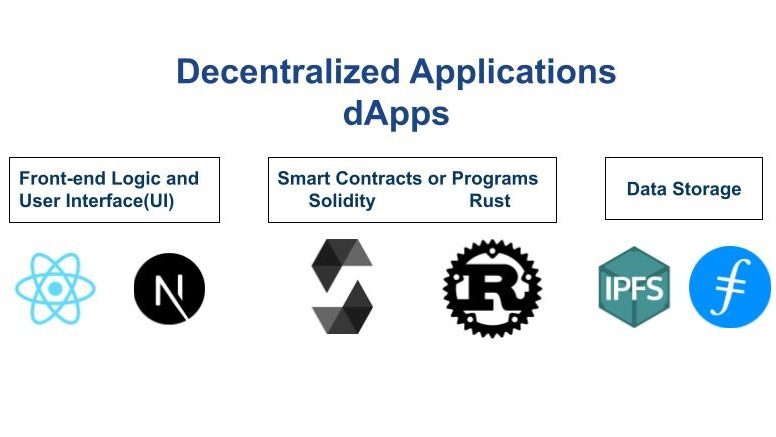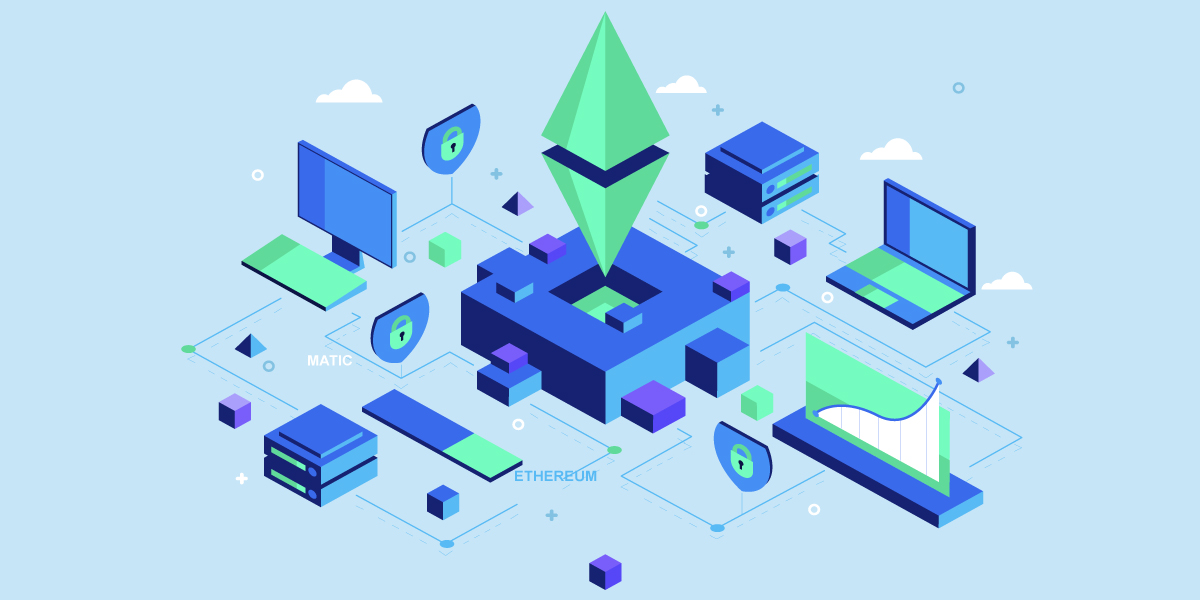Table of Contents
If you want to entertain the idea of building a dApp, you must know what are its core features.
Do you remember the last time you used a dApp? They’re not very common so the answer could be an easy no.
Even developers sometimes cannot differentiate between a decentralized application from a traditional application. So understandably, it’s a learning curve and it may be bigger if you plan to build one.
Hence before you start building one, you should load on some essential dApp knowledge. First let’s start with understanding,
What is a dApp?
dApps are applications that don’t rely on a centralized server or system. Which is why the ‘d’ in ‘dApp’ stands for decentralized. Adding on, dApps make use of Web3 technologies like blockchain and contain functions, logic which makes them rigid and secure.
To further explain, dApps have a backend code running on blockchains. Contrary to that, on a traditional application, the backend logic is stored on a centralized platform.
Other than being highly secure & having tamper-proof smart contracts, dApps have several other benefits which aren’t offered by Web2 applications. For example:
- Enhanced privacy
- Anonymity
- Censorship resistance
- Zero downtime
- Trustlessness
Components of a decentralized application

Three main components which contribute to a dApp are:
1. Frontend & user interface
A code’s backend logic and functions are taken care of by smart contracts written in languages like Solidity. The front-end or client side of the dApp is coded using standard web technologies such as HTML for markup and Javascript.
This enables the developer to use familiar libraries, frameworks, and tools. The client-side program is linked to the smart contract via client-side libraries such as Web3.js and Ether.js.
Interaction with the smart contract is done using web3 wallets like MetaMask and Torus Wallet
2. Smart contracts
Smart contracts store the application’s logic along with the state of the application. This is the fundamental difference between a decentralized Web3 application and a traditional web2 application. This gives it all the benefits of a dApp as mentioned above. Smart contracts are the basis of building a dApp.
3. Data storage
The majority of applications need to store data, however, due to the scattered nature of blockchains, keeping data on-chain can be very costly and not suitable.
That’s why most dApps store their data on off-chain decentralized storage services such as IPFS or Filecoin. This makes blockchain use only for crucial logic and functions state of the application.
One might also use a cloud-based service like AWS or Azure, but this defeats the decentralized goal of the application.
Difference between a dApp and traditional App
| Basis of comparison | Centralized Apps 🪢 | Decentralized Apps ⛓ |
| Definition | A single firm owns and manages the code and functions of the application | The dApp runs on a blockchain |
| User Interaction | Interacts with a traditional program | Interacts with a program based on smart contracts |
| Backend Code | Operates on centralized servers such as AWS or Google Cloud | Operates on a peer-to-peer network |
| Security | Less secure | More secure |
| System | If a server goes down, the whole app faces down-time | If a node goes down the app continues to function normally |
| Which one’s for you? | If you want a system easier to manage, then go for centralized apps | If your end goal is to benefit from security, better go for decentralized apps |
Pros and cons of decentralized applications
Building and using a dApp comes with its own set of pros and cons. It’s extremely important to dive into a subject with clarity, so you should explore advantages and disadvantages of dApps.
Advantages of dApps
- It remains fully functional despite the server going down. So users will be able to access the app.
- It’s decentralized, hence, users will benefit from the additional security that comes from dApps.
- User data will not suffer a breach or hacking attempt.
Disadvantages of dApps
- It’s difficult to fix a bug, considering the rigidity of a smart contract on a blockchain.
- Limited target audience, because of the lack of understanding around the Web3 ecosystem
- Expensive for short-term applications, as dApp transactions are costly and slower and they require gas charges. It can be difficult to attract users in the early stages.
Examples of web3 dApps
As of late, hundreds of web3 dApps have emerged and given netizens a renewed sense of using the web. Shown below are some of the most popular examples of dApps that are actually enjoying a high number of users.
1. Cryptokitties
This is a blockchain-based game that allows users to buy, sell, and breed virtual cats. It was one of the first popular dApps and was launched in 2017.
2. Augur
This is a decentralized prediction market platform that allows users to create and participate in markets on a wide range of topics. It was launched in 2015.
3. Uniswap
Uniswap is a decentralized exchange that allows users to trade Ethereum-based tokens. It was launched in 2018 and has become one of the most popular dApps on the Ethereum network.
4. MakerDAO
This is a decentralized platform that allows users to borrow and lend digital assets using smart contracts. It was launched in 2017 and has become one of the most widely used dApps in the Ethereum ecosystem.
The typical tech stack for building a dApp
Let’s explore an overview of the tech stack you must rely on in order work on a dApp.
- ReactJS/NextJS – front-end JavaScript frameworks
- TypeScript – for creating stable and better web pages
- Web3.js – helps to connect the webpage to blockchain
- EtherJS – a high-level library similar to Web3.js
- Truffle – development tool for smart contract development
- Solidity – programming language used to write smart contracts on the Ethereum Blockchain
Basic steps for building a dApp
Building a dApp (decentralized application) involves the following steps:
Step 1: Choose a blockchain
The first step in building a dApp is to choose a blockchain to build on. There are several options to choose from, including Ethereum, Solana, and TRON. Each blockchain has its own unique features and capabilities, so it’s important to choose one that meets the needs of your dApp.
Step 2: Set up a development environment
Next, you’ll need to set up a development environment that allows you to build and test your dApp. This typically involves installing a local blockchain testnet, such as Ganache, as well as a set of development tools, such as Truffle and Web3.js.
Step 3: Design the smart contracts
A dApp typically consists of one or more smart contracts, which are self-executing contracts with the terms of the agreement between buyer and seller being directly written into lines of code. You’ll need to design and write the smart contracts that form the backbone of your dApp.
Step 4: Develop the front-end
Once the smart contracts are complete, you’ll need to develop the front-end of your dApp, which is the user interface that people will interact with. This typically involves building a web application using HTML, CSS, and JavaScript.
Step 5: Test and deploy the dApp
Before you can release your dApp to the public, you’ll need to thoroughly test it to ensure that it is bug-free and secure. Once you’re confident in the stability of your dApp, you can deploy it to a public blockchain, such as the Ethereum mainnet, so that it can be accessed by anyone.
Building a dApp can be a complex process, and it typically requires a good understanding of blockchain technology, smart contracts, and web development. However, with the right tools and resources, it is possible for anyone to build a dApp.
So why need dApps anyway?
Three powerful terms: User control, free speech, and censorship resistance.
A decentralized dApp enables users to have more control and no single group dictates the fate of the app and its users. They don’t have a central authority, and they foster independence and freedom for their users.
On the other hand, centralized applications have as of late just become data breachers and stealers. It’s annoying that they know so much about us. Plus, they’re highly vulnerable to attacks.
So it all should stop, and one way to do it is by building dApps. It can prove to be a very impactful project for a developer.
So now that you’re aware of everything, go ahead and build your very first dApp. You can go check out our website for several beginner-friendly and advanced dApp projects. 👇🏼
